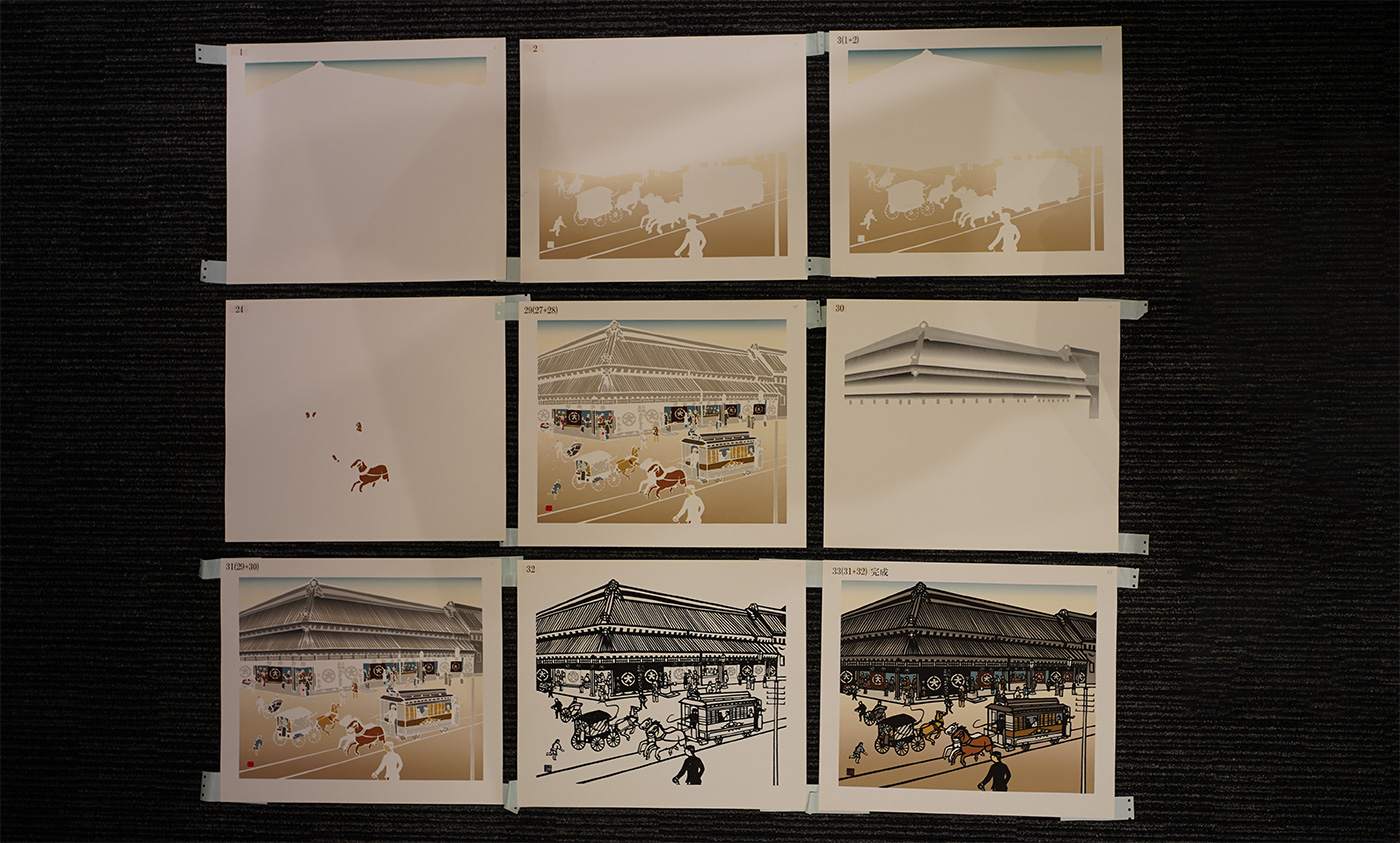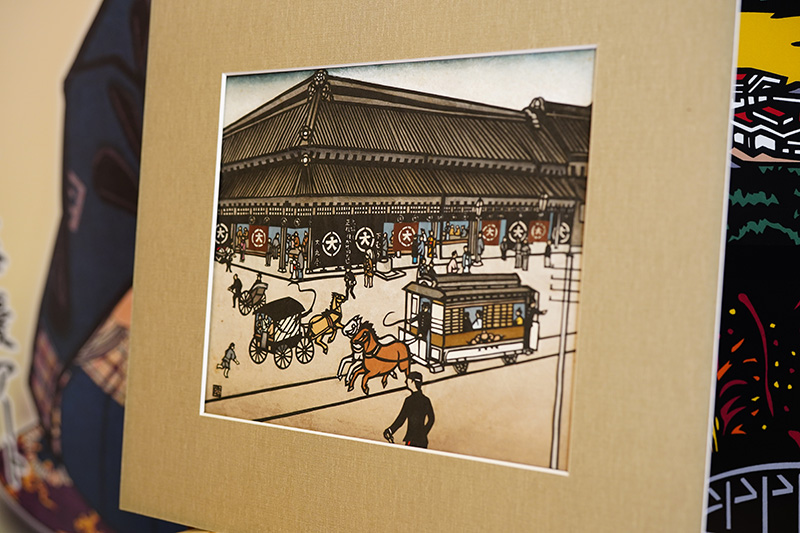Welcome to Fujikei Art
An Ukiyo-e exhibition of Utamaro, Sharaku, Hokusai, Hiroshige, and Kuniyoshi was held at the Fukuoka City Museum of Art. The work on display there was collected from all over the world and they are treasures of Japan.
I think the greatest of these five Ukiyo-e artists are Hokusai and Hiroshige. The number of works of these two people is so incredibly large, Hiroshige having painted 20,000 pictures throughout his life. Moreover, these two artists had a great influence on the impressionist school such as Van Gogh and Monet.
The purpose of opening this gallery is to continue the legacy of my ancestors who were Ukiyo-e producers, producing Ukiyo-e by Hiroshige under the trademark of Fujikei and Fujihiko. Moreover, although Hiroshige’s works published by my ancestors are not all well known, they include masterpieces such as “Beautiful Ladies in Tokaido”, “Eights Views of the Eastern Capital”, and “Two Hares Watching the Moon”. We have opened Fujikei Art as a mission of descendants to convey to everyone the beauty of Hiroshige.
Furthermore, I am compelled to create this venue to highlight two more contemporary artists, Shunji Mizuno, a talented Kirie artist and my great aunt, Michiyo Matsuura, a talented Kusae artist. They grew up in Fujiokaya, and their works were in the influence of Fujiokaya tradition.
Just as music such as Bach and Mozart blossomed at the top of musical tradition, all deep art is a developmental inheritance of tradition. Observing their works you can see the influence of tradition in Ukiyo-e.
To show the spirit of Fujiokaya we open “Fujikei Art.”
April 1, 2020
Director, Ito Kirie Gallery
Hiroshi Mizuno
Produced by Fujikei Art (The technique of silk printing made into photographic prints)
With the cooperation of art director Akira Kamihara, we have produced seven silk prints (“Oiran Courtesan’s Parade,” “Dawn of Civilization Opening,” “Colored Leaves ,” “Lantern Hymn,” “Fireworks,” “Kuju Plateau,” and “Japanese Patterns.”
These works reproduce the texture of Mizuno’s Kirie, and at a distance, they are indistinguishable from the original Kirie. Shunji Mizuno produced colored Kirie that captures the texture of the woodblock print. The reason I produced silk prints from Kirie is that I was particular about the effects they offer.
In the old days, western prints were made from copper plates, however, colored woodblock prints were unique to Japan. The way of stacking many color blocks and the final step of stacking black ink blocks is unique to Ukiyo-e, requiring skilled craftmenship of block print artists.
As with all craftsmanship, the refined skills of sculptors and block print artists fade with the times. In particular, the “Dawn of Civilization”was hand pressed 33 times, but few craftsmen with such skill are present today. I think that the fine silk prints that we have made here are technically not able to ever be reproduced.
On the other hand, with advances in image processing technology, we have been able to perform color separation, make plates on computers, and process color and lines as we do with silk prints. With the cooperation of Masashi Ozaki, a leading expert in this technology, I made the cut-out painting “Garden of Daisenin” as a photographic print, and I think I was able to create a wonderful work which has turned out quite remarkably.
The point of photographic prints is that they are stored on a computer, so there are no restrictions on the number of copies one may make. Once you’ve made a version, you can always make as many as you like. Therefore, the cost is less than for silk prints.
At Fujikei Art, we are planning to produce works by Hiroshige, Shunji Mizuno, and Michiyo Matsuura through photographic prints. All of them are produced at the Sata Print Studio, and the more I observe them, the more I think they are reproduced with subtle nuances that are usually beyond the scope of photographic prints. The paper is made of cotton with a Japanese paper texture, allowing one to appreciate it as an image of Ukiyo-e, Kirie, and natural plant-dyed paper paintings of Kusae.

Produced by Fujikei Art (The technique of silk printing made into photographic prints)
With the cooperation of art director Akira Kamihara, we have produced seven silk prints (“Oiran Courtesan’s Parade,” “Dawn of Civilization Opening,” “Colored Leaves ,” “Lantern Hymn,” “Fireworks,” “Kuju Plateau,” and “Japanese Patterns.”
These works reproduce the texture of Mizuno’s Kirie, and at a distance, they are indistinguishable from the original Kirie. Shunji Mizuno produced colored Kirie that captures the texture of the woodblock print. The reason I produced silk prints from Kirie is that I was particular about the effects they offer.
In the old days, western prints were made from copper plates, however, colored woodblock prints were unique to Japan. The way of stacking many color blocks and the final step of stacking black ink blocks is unique to Ukiyo-e, requiring skilled craftmenship of block print artists.
As with all craftsmanship, the refined skills of sculptors and block print artists fade with the times. In particular, the “Dawn of Civilization”was hand pressed 33 times, but few craftsmen with such skill are present today. I think that the fine silk prints that we have made here are technically not able to ever be reproduced.
On the other hand, with advances in image processing technology, we have been able to perform color separation, make plates on computers, and process color and lines as we do with silk prints. With the cooperation of Masashi Ozaki, a leading expert in this technology, I made the cut-out painting “Garden of Daisenin” as a photographic print, and I think I was able to create a wonderful work which has turned out quite remarkably.
The point of photographic prints is that they are stored on a computer, so there are no restrictions on the number of copies one may make. Once you’ve made a version, you can always make as many as you like. Therefore, the cost is less than for silk prints. At Fujikei Art, we are planning to produce works by Hiroshige, Shunji Mizuno, and Michiyo Matsuura through photographic prints. All of them are produced at the Sata Print Studio, and the more I observe them, the more I think they are reproduced with subtle nuances that are usually beyond the scope of photographic prints. The paper is made of cotton with a Japanese paper texture, allowing one to appreciate it as an image of Ukiyo-e, Kirie, and natural plant-dyed paper paintings of Kusae.


Fujikei Art Price List
Each work has an explanation. (with English explanation)
| Plate making/Calibration fee | Copyright image usage fee | Selling price | Framed price | |
| Hiroshige, Hokusai, Kinjiro | JPY13,000 | JPY5,000 | JPY18,000 | JPY30,000 |
| Kirie/Kusae Color Printprinting | ||||
| Colored paper | JPY5,000 | JPY10,000 | JPY15,000 | JPY18,000 |
| Standard size | JPY13,000 | JPY10,000 | JPY23,000 | JPY35,000 |
| Large size | JPY18,000 | JPY10,000 | JPY28,000 | JPY45,000 |
| Kirie Silk Print (Solid Color) Standard | JPY5,000 | JPY10,000 | JPY15,000 | JPY27,000 |
| Kirie Silk Prints (Solid Color) Large Format | JPY15,000 | JPY10,000 | JPY25,000 | JPY42,000 |
| Kirie Silk Prints(20 sliding) Standard | JPY30,000 | JPY10,000 | JPY40,000 | JPY52,000 |
| Kirie Silk Prints(33 sliding) Standard | JPY40,000 | JPY10,000 | JPY50,000 | JPY62,000 |
| Kirie Silk Prints(20 sliding) Large format | JPY50,000 | JPY10,000 | JPY60,000 | JPY77,000 |
| Kirie Silk Prints(33 sliding) Large format | JPY60,000 | JPY10,000 | JPY70,000 | JPY87,000 |
Prints have editions.
| Ukiyo-e and Kirie postcards | JPY100 |
| Hiroshige “Eight Views in Eastern Capital” Set of 8 postcards | JPY1,000 |
| S. Mizuno “Creative Kirie” Set of 8 postcards | JPY1,000 |
| Kirie Book | |
| S. Mizuno “Japan through a Cutter Knife” | JPY5,500 |
Order of the picture frame. Four colors of the mat.
| Ebony luxury frame | |
| with mat | JPY12,000 |
| Large frame with mat | JPY17,000 |
| Frame for Shikisi | |
| Luxury frame(wooden) | JPY5,000 |
| Scroll | |
| Kirie (Takasago, Kagami Shisi, Renshishi) | JPY20,000 |
| Ukiyo-e (Two Hares watching the Moon) | JPY23,000 |
| Kinjiro Ninomiya Handwriting | JPY23,000 |
